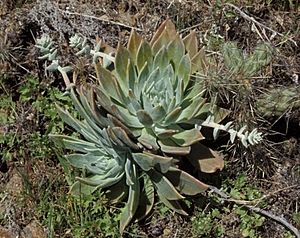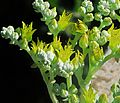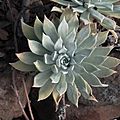Santa Barbara Island liveforever facts for kids
Quick facts for kids Santa Barbara Island liveforever |
|
|---|---|
 |
|
| Conservation status | |
| Scientific classification | |
| Genus: |
Dudleya
|
| Species: |
traskiae
|
| Synonyms | |
|
|
The Dudleya traskiae is a very rare succulent plant. It is also known as the Santa Barbara Island liveforever. This plant is only found on Santa Barbara Island. This island is one of the Channel Islands of California. It likes to grow on rocky cliffs and slopes. The plant has a group of flat, spade-shaped leaves at its base. These leaves can be up to 15 centimeters (about 6 inches) long. They are usually pale green or yellowish. The plant also grows tall stems with many bright yellow flowers. These flowers grow in round, dense clusters.
Contents
About the Santa Barbara Island Liveforever
The Dudleya traskiae is a perennial succulent plant. This means it lives for many years and has thick, fleshy leaves that store water. Its leaves grow in a circle, like a rose, at the base of the plant. These plants stay green all year round. They have a main stem that can branch out. Each branch can have many leaf circles.
The plant usually has 25 to 35 leaves in each circle. The leaves are shaped like straps or spades. They are about 4 to 15 centimeters (1.5 to 6 inches) long. They are also 1 to 4 centimeters (0.4 to 1.5 inches) wide. The leaves can be green or have a waxy, whitish coating.
When the plant flowers, it grows stems from the leaf circles. The flowers are bright yellow and often have red lines. There are five petals on each flower. They are joined at the bottom and curve outwards at the top. The plant usually flowers from May to July. Sometimes, it can start flowering as early as February.
Where the Plant Lives
The Dudleya plants mostly grow in California. Some can also be found in southern Oregon, Arizona, Nevada, and down to Baja California, Mexico. You can find Dudleya plants on all eight of the Channel Islands. But the Dudleya traskiae is special because it only lives on Santa Barbara Island in California.
There are only about ten places on this 652-acre island where this plant grows. All the known spots are in rocky areas. They are usually on the steep slopes around the edge of the island. They also grow on rocky parts inside shallow canyons. In these areas, other plants do not grow very tall.
Most of these plants are found on the eastern, southeastern, and southwestern sides of the island. There are no Dudleya traskiae plants on the northern and northwestern sides of the island right now. The plant's home is often called a "maritime cactus scrub." This means it is a coastal area with cacti and other low-growing plants. Some of these plants include cholla, prickly pear, boxthorn, and Santa Barbara Island buckwheat.
Protecting This Rare Plant
The Dudleya traskiae is listed as an endangered species in the United States. This means it is in danger of disappearing forever.
In the past, many animals brought to the island caused problems for this plant. In the 1800s, many wild goats ate the native plants. Later, other animals like cats, sheep, and rabbits also harmed the island's plants. In the early 1900s, people also used the island for farming. They grew crops like barley, oats, and potatoes. This also affected the native plants.
In 1984, there were only about 534 D. traskiae plants on the island. By 2004, the number grew to about 852 plants. About 80 plants were grown by people and then planted back in suitable areas.
It is hard for the Dudleya traskiae population to grow quickly. Some plants do not make many seeds. Also, some of the seeds are not able to grow into new plants. Sometimes, deer mice eat the seeds. But sometimes, when the mice hide the seeds, they actually help spread them around. Young plants that start to grow can be eaten by mice or by insect larvae. Some plants also die during droughts.
Other dangers to the plant include damage from brown pelicans nesting. Also, erosion (when soil washes away) and new plant species brought to the island can harm them.
To help protect the plant, people are working to keep visitors away from sensitive areas. They are also doing research and planting more Dudleya traskiae plants. All the animals that were brought to the island and caused harm, like the rabbits and hares, have now been removed.
Images for kids
See also
 In Spanish: Dudleya traskiae para niños
In Spanish: Dudleya traskiae para niños





